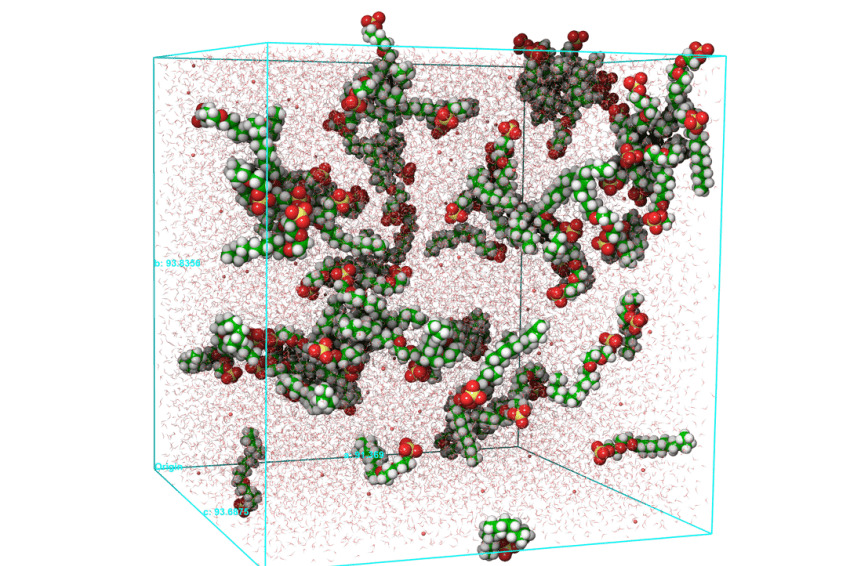Digital Molecular Design
Computer-Driven Modeling Accelerates the Development of Sustainable Materials
A violently quaking earth destroyed 17,000 houses, the falling candles initiated fires throughout the city, a tsunami devastated any remaining survivors on the beach and, finally, the subsequent looting completed the apocalyptic scenario in Lisbon on 1. November 1755.
The consternation throughout Europe in the aftermath of this disaster was enormous; Voltaire published his Poème sur le désastre de Lisbonne, in which he breaks with the optimism of an intrinsically wise world. That change in perception of the world turned out to accelerate the flywheel of modern thinking – the European Enlightenment – which became a principle of modern science.
A key benefit in this process of scientification of human society – of the data-driven anticipation of what’s to come – is that it helps us in the prevention of disasters by anticipating solutions. Traditionally, this innovative process of modern science has been based solely, or to an overwhelming degree, on experimental, empirical data. However, with the ongoing exponential speedup and scalability of supercomputers, we are now capable of producing simulated in-silico data at an accuracy matching experimental methods, but at unprecedented scale. We are facing an unsustainable future, but we have the power of modern science and especially the power of computer simulation to change the course.
New Materials for the "Green Deal”
With the goal to build a more sustainable and circular economy, the European Union signed the “Green Deal”. While potentially revolutionary in its impact, the Green Deal presents a disruption to the entire chemical process chain and its associated industries. Chemicals which have been used for decades can no longer be employed and manufacturers are challenged to find sustainable replacements. We need new materials, and we need them fast. Fortunately, the continual march of scientific progress promises faster answers than in the past.
Computer-driven molecular design, with its ability to generate massive quantities of simulated data, facilitates entry into new frontiers of chemical discovery for novel materials. It brings the promise of speed, accuracy and allows us to scan through large molecular space to triage down and experimentally test only the most promising molecules.
The potential methodologies for computer-driven molecular design are varied, with algorithms that have been under persistent scientific development for decades. The approaches can be broken down into two categories:
1. Knowledge-based machine learning, what for better or worse is now often referred to as AI. This has received a lot of attention recently because of its ability to beat humans at chess and Go, recognize faces in photos almost as well as humans, and drive cars almost as well as humans – so the obvious question is: how good is it at designing novel molecules?
2. Rigorous, first principles physics-based models that accurately describe the true physics underlying the molecular properties. This requires major advances in the underlying science of molecular interactions and also major advances in compute power.
If we aim for a design process that both covers large chemical space and offers precision at the experimental level, then the interplay between machine learning and physics is key. From a compute time perspective, it is faster to enumerate and ideate billions of molecules and filter them down with either knowledge-based algorithms or simple physics-based methods. The surviving molecules in that filter process will then be calculated with the most accurate physics-based methods to obtain results at experimental accuracy. The best compounds can then be taken again as base for generating molecular derivatives and the cycle can be repeated until a set of compounds with the desired molecular properties are calculated.
Not only the interplay between the various computational methods is key, also the interplay between experimental and in-silico data. Being able to interpret both data types in aggregate as well as being able to generate in-silico data based on known experimental data is indispensable. Also, the interpretation of experimental data with simulation methods leads to a new kind of uncertainty principle where interpretation of experimental and in-silico data cannot be disentangled any longer. Lab automation and contextualizing large datasets, both experimental and in-silico, go hand-in-hand. However, the principles of human decision-making in modern sciences stay still the same, just the nature of the underlying data has changed.
Green Chemistry with Molecular Design
A few examples for computer-driven molecular design of materials demonstrate the power of the approach to push society into new frontiers of green chemistry:
At the International Elastomer Conference in Pittsburgh, Schrödinger’s scientist Atif Afzal presented a collaboration with Evonik on “Using Molecular Simulation to Assess the Impact of Additives and Macrocyclic Structures on Vestenamer”. Evonik is taking a lead role on circular economy. One of their products here is Vestenamer, which can be used as a process additive for rubber recycling. Europe generates 3.6 million metric tons of scrap tires annually. To recycle these huge amounts of used tires, products like Vestenamer are needed.
In their collaboration, Evonik and Schrödinger investigated the molecular behavior of Vestenamer when applied in rubber recycling. Simulation technologies can assist understanding the process on the molecular level, so that the optimal processing conditions and further application areas could be found. In this particular work, the interactions of Vestenamer with various rubber polymers and typical crosslinking additives were shown, so that structural and thermophysical properties could be predicted. The work also provided insights into how Vestenamer helps to connect different rubber polymers and then leads to a better recyclability of the mixture.
In Schrödinger’s User Group Meeting in September 2021, Mariam Hussain and Martin Settle from Reckitt presented in their talk “Accelerating Formulation and Packaging Development Using Molecular Dynamics” how digital methods can help design new consumer products faster. The consumer goods area is a fast-paced business, since the change of demand is one of the few constants here. Especially in this environment, the Green Deal and the demand for more sustainable products are having a strong impact on the innovation process. Which new bio-based surfactant might be the best for a given application? Companies like Reckitt must find a way to evaluate new chemicals and materials and how they would fit for a given product.
Rational molecular design applying simulation technologies can significantly speed up the design process for consumer goods and therefore bring new ideas quicker to market. Mariam and Martin showed how simulations are used at Reckitt to digitally assess new ideas for product formulations and packaging. New ingredients like surfactants or polymers are screened with simulation approaches with respect to a target property and behavior and then the best candidates are moved forward to testing. Filtering the best candidates to be screened, rather than testing all candidates, is crucial for acceleration in the design process, since an experimental test for a new product of a new packaging could take up to months. One particular example presented was the selection of new surfactants for detergent application and how they interact with coatings on fabrics. With simulation approaches, the Reckitt scientist could evaluate new surfactants being offered by their suppliers and screen for the best ones for a given application. On average, these digital approaches show a 10-fold acceleration of the innovation process compared to the purely experimental one.
In his role as Director of Sustainability, Martin also outlined that molecular simulations are crucial to accelerate their innovation, particularly for bringing in new, more sustainable chemistries to their products and packaging. By 2030 Reckitt plans to have 50% of net revenue coming from more sustainable products.
The benefits of molecular simulation are not limited to large chemical industrial companies. Simulations are helpful to accelerate innovation for smaller companies and nimble startups where predictive approaches have a crucial value in exploring new materials or new application areas quickly. A recent example was presented by Cambium Biomaterials, a California-based startup for biopolymers. Chief Technology Officer, Andrew Guenthner, presented how the adoption of Schrödinger technology is used to evaluate new biobased polymers for flame retardants in aerospace applications. Bio-based feedstocks bring in new monomeric units that offer a new design space for epoxy resins. This design space is much bigger compared to the traditional raw oil-based bisphenol-based compounds. The simulations helped screen target properties such as glass transition temperature or mechanical responses with respect to molecular composition and processing conditions. These digital approaches helped Cambium to design new biobased flame retardants that exhibit a better performance in aerospace application than traditional raw-oil based ones. Again, a digital approach to screen a library of various candidates led to an accelerated innovation process.
Society rightly so demands that industrial production becomes more sustainable and circular to prevent an apocalyptic future. Modern science and in particular digital molecular design can play a critical role in this industrial transformation process towards a future we all like to live in. Let’s get it done.
Author:
Jörg Weiser, Managing Director, Schrödinger GmbH, Munich, Germany
_______________________________________________
Digital Chemistry & Materials Innovation
In a lecture series by Schrödinger in cooperation with CHEManager, you can learn more about digital transformation in chemistry and materials science:
https://bit.ly/MolecularModelling.









